Cross-Cultural Management Report: Analysis of Cultural Differences
VerifiedAdded on 2022/11/23
|13
|3228
|71
Report
AI Summary
This report provides a comprehensive analysis of cross-cultural management, examining its significance in a globalized business environment. It delves into the core concepts, including the impact of cultural differences on organizational behavior and national-level operations. The report identifies problems associated with cross-cultural management, such as communication barriers and differing work ethics, while also highlighting its advantages, like increased innovation and global market access. Furthermore, it outlines the principles of effective cross-cultural management, emphasizing the importance of understanding, respecting, and adapting to diverse cultural contexts. The report also addresses the challenges of cultural differences, such as prejudices and stereotypes, and suggests strategies for building inclusive and diverse workplaces, including revising hiring practices and providing sensitivity training. The reflective component of the report discusses the student's personal insights and learning experiences related to cross-cultural management, emphasizing the importance of adaptability and continuous cultural reassessment.
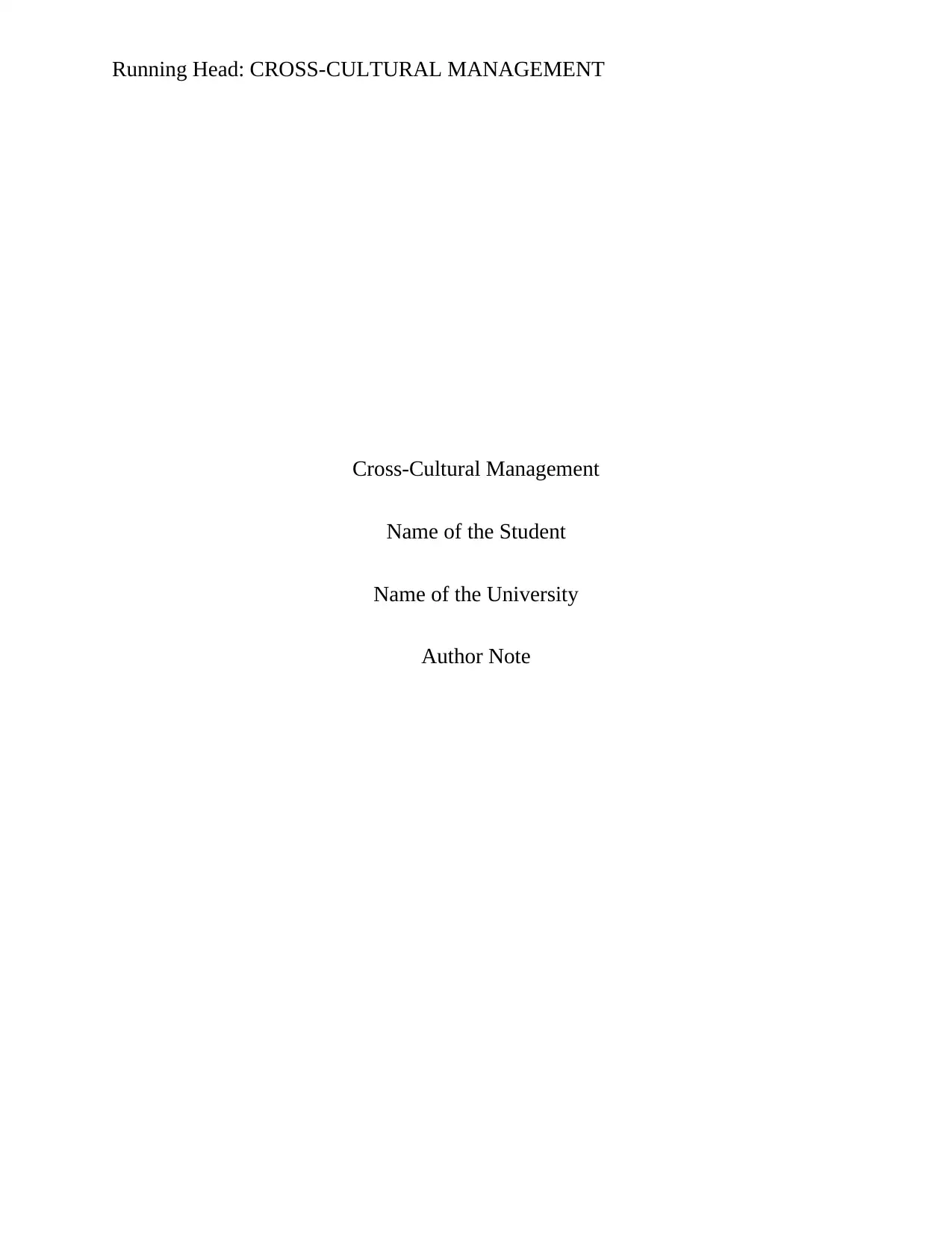
Running Head: CROSS-CULTURAL MANAGEMENT
Cross-Cultural Management
Name of the Student
Name of the University
Author Note
Cross-Cultural Management
Name of the Student
Name of the University
Author Note
Paraphrase This Document
Need a fresh take? Get an instant paraphrase of this document with our AI Paraphraser
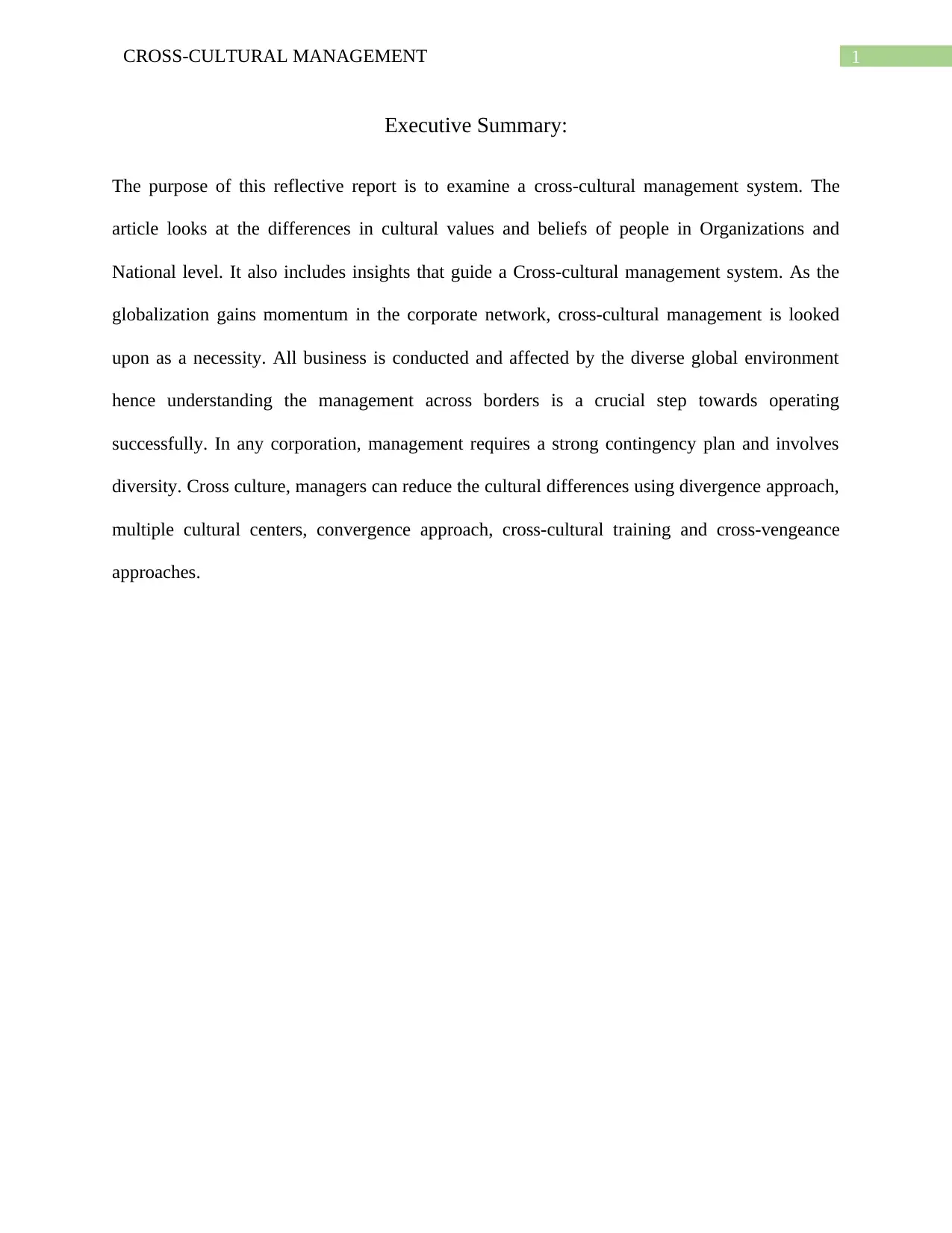
1CROSS-CULTURAL MANAGEMENT
Executive Summary:
The purpose of this reflective report is to examine a cross-cultural management system. The
article looks at the differences in cultural values and beliefs of people in Organizations and
National level. It also includes insights that guide a Cross-cultural management system. As the
globalization gains momentum in the corporate network, cross-cultural management is looked
upon as a necessity. All business is conducted and affected by the diverse global environment
hence understanding the management across borders is a crucial step towards operating
successfully. In any corporation, management requires a strong contingency plan and involves
diversity. Cross culture, managers can reduce the cultural differences using divergence approach,
multiple cultural centers, convergence approach, cross-cultural training and cross-vengeance
approaches.
Executive Summary:
The purpose of this reflective report is to examine a cross-cultural management system. The
article looks at the differences in cultural values and beliefs of people in Organizations and
National level. It also includes insights that guide a Cross-cultural management system. As the
globalization gains momentum in the corporate network, cross-cultural management is looked
upon as a necessity. All business is conducted and affected by the diverse global environment
hence understanding the management across borders is a crucial step towards operating
successfully. In any corporation, management requires a strong contingency plan and involves
diversity. Cross culture, managers can reduce the cultural differences using divergence approach,
multiple cultural centers, convergence approach, cross-cultural training and cross-vengeance
approaches.
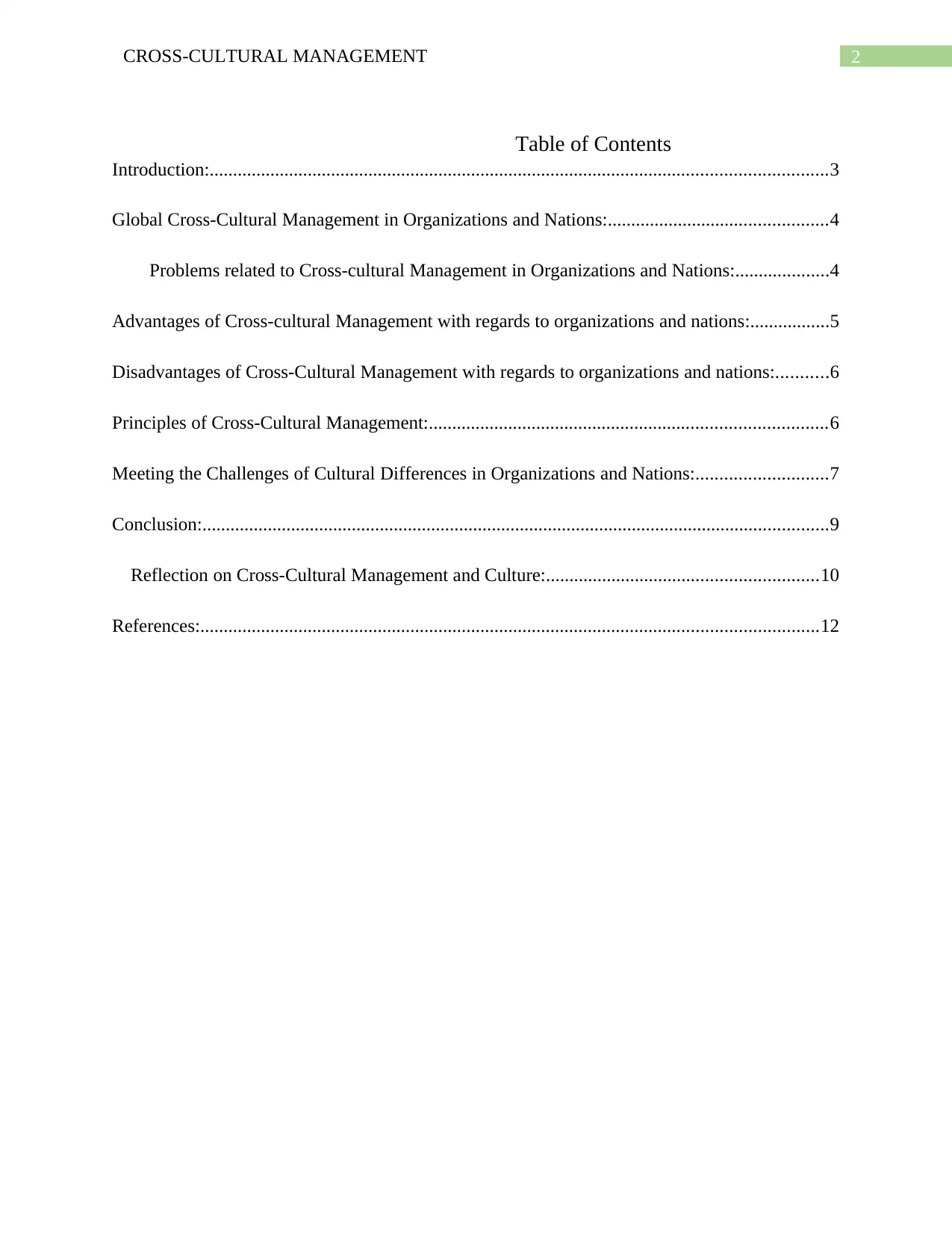
2CROSS-CULTURAL MANAGEMENT
Table of Contents
Introduction:....................................................................................................................................3
Global Cross-Cultural Management in Organizations and Nations:...............................................4
Problems related to Cross-cultural Management in Organizations and Nations:....................4
Advantages of Cross-cultural Management with regards to organizations and nations:.................5
Disadvantages of Cross-Cultural Management with regards to organizations and nations:...........6
Principles of Cross-Cultural Management:.....................................................................................6
Meeting the Challenges of Cultural Differences in Organizations and Nations:............................7
Conclusion:......................................................................................................................................9
Reflection on Cross-Cultural Management and Culture:..........................................................10
References:....................................................................................................................................12
Table of Contents
Introduction:....................................................................................................................................3
Global Cross-Cultural Management in Organizations and Nations:...............................................4
Problems related to Cross-cultural Management in Organizations and Nations:....................4
Advantages of Cross-cultural Management with regards to organizations and nations:.................5
Disadvantages of Cross-Cultural Management with regards to organizations and nations:...........6
Principles of Cross-Cultural Management:.....................................................................................6
Meeting the Challenges of Cultural Differences in Organizations and Nations:............................7
Conclusion:......................................................................................................................................9
Reflection on Cross-Cultural Management and Culture:..........................................................10
References:....................................................................................................................................12
⊘ This is a preview!⊘
Do you want full access?
Subscribe today to unlock all pages.

Trusted by 1+ million students worldwide
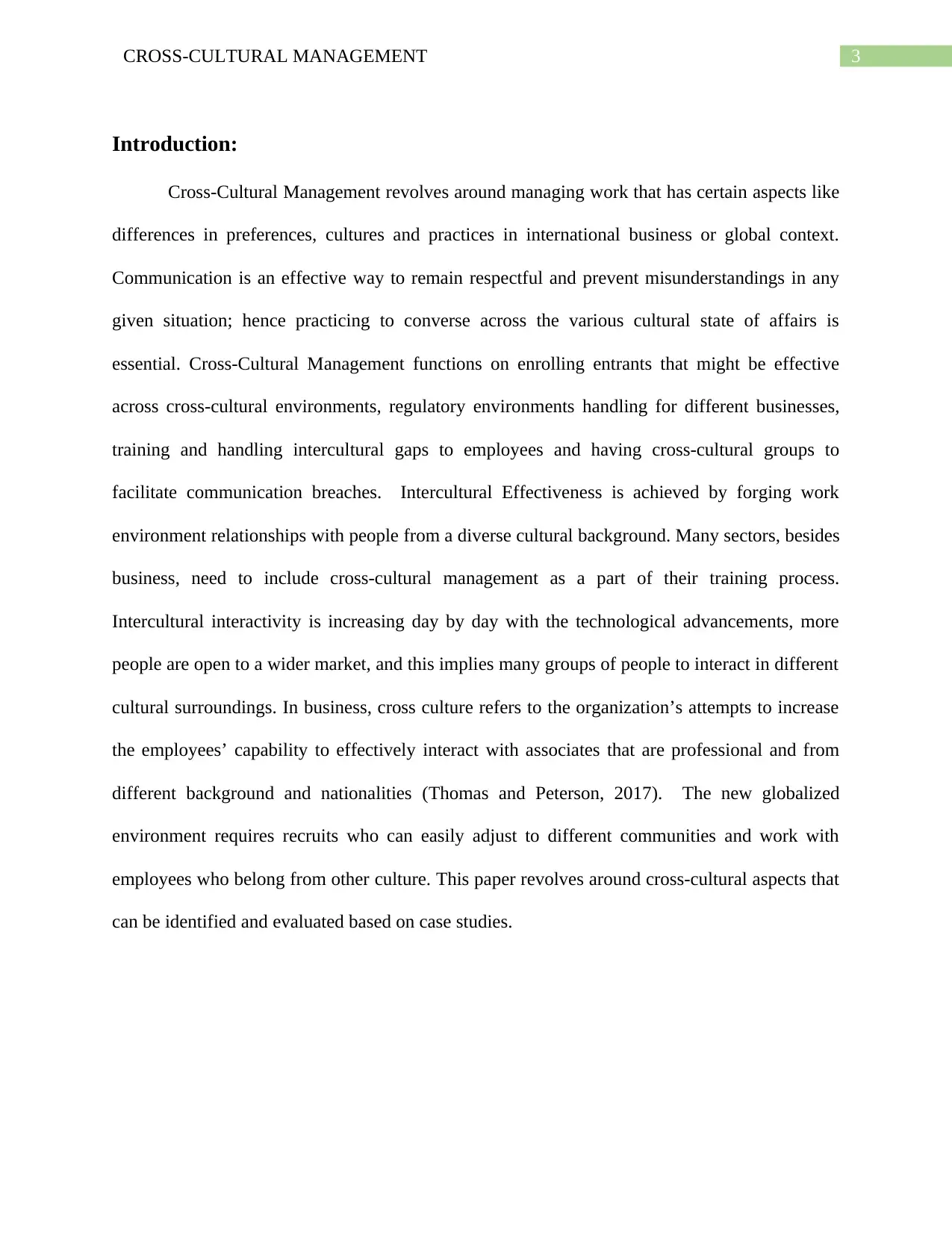
3CROSS-CULTURAL MANAGEMENT
Introduction:
Cross-Cultural Management revolves around managing work that has certain aspects like
differences in preferences, cultures and practices in international business or global context.
Communication is an effective way to remain respectful and prevent misunderstandings in any
given situation; hence practicing to converse across the various cultural state of affairs is
essential. Cross-Cultural Management functions on enrolling entrants that might be effective
across cross-cultural environments, regulatory environments handling for different businesses,
training and handling intercultural gaps to employees and having cross-cultural groups to
facilitate communication breaches. Intercultural Effectiveness is achieved by forging work
environment relationships with people from a diverse cultural background. Many sectors, besides
business, need to include cross-cultural management as a part of their training process.
Intercultural interactivity is increasing day by day with the technological advancements, more
people are open to a wider market, and this implies many groups of people to interact in different
cultural surroundings. In business, cross culture refers to the organization’s attempts to increase
the employees’ capability to effectively interact with associates that are professional and from
different background and nationalities (Thomas and Peterson, 2017). The new globalized
environment requires recruits who can easily adjust to different communities and work with
employees who belong from other culture. This paper revolves around cross-cultural aspects that
can be identified and evaluated based on case studies.
Introduction:
Cross-Cultural Management revolves around managing work that has certain aspects like
differences in preferences, cultures and practices in international business or global context.
Communication is an effective way to remain respectful and prevent misunderstandings in any
given situation; hence practicing to converse across the various cultural state of affairs is
essential. Cross-Cultural Management functions on enrolling entrants that might be effective
across cross-cultural environments, regulatory environments handling for different businesses,
training and handling intercultural gaps to employees and having cross-cultural groups to
facilitate communication breaches. Intercultural Effectiveness is achieved by forging work
environment relationships with people from a diverse cultural background. Many sectors, besides
business, need to include cross-cultural management as a part of their training process.
Intercultural interactivity is increasing day by day with the technological advancements, more
people are open to a wider market, and this implies many groups of people to interact in different
cultural surroundings. In business, cross culture refers to the organization’s attempts to increase
the employees’ capability to effectively interact with associates that are professional and from
different background and nationalities (Thomas and Peterson, 2017). The new globalized
environment requires recruits who can easily adjust to different communities and work with
employees who belong from other culture. This paper revolves around cross-cultural aspects that
can be identified and evaluated based on case studies.
Paraphrase This Document
Need a fresh take? Get an instant paraphrase of this document with our AI Paraphraser
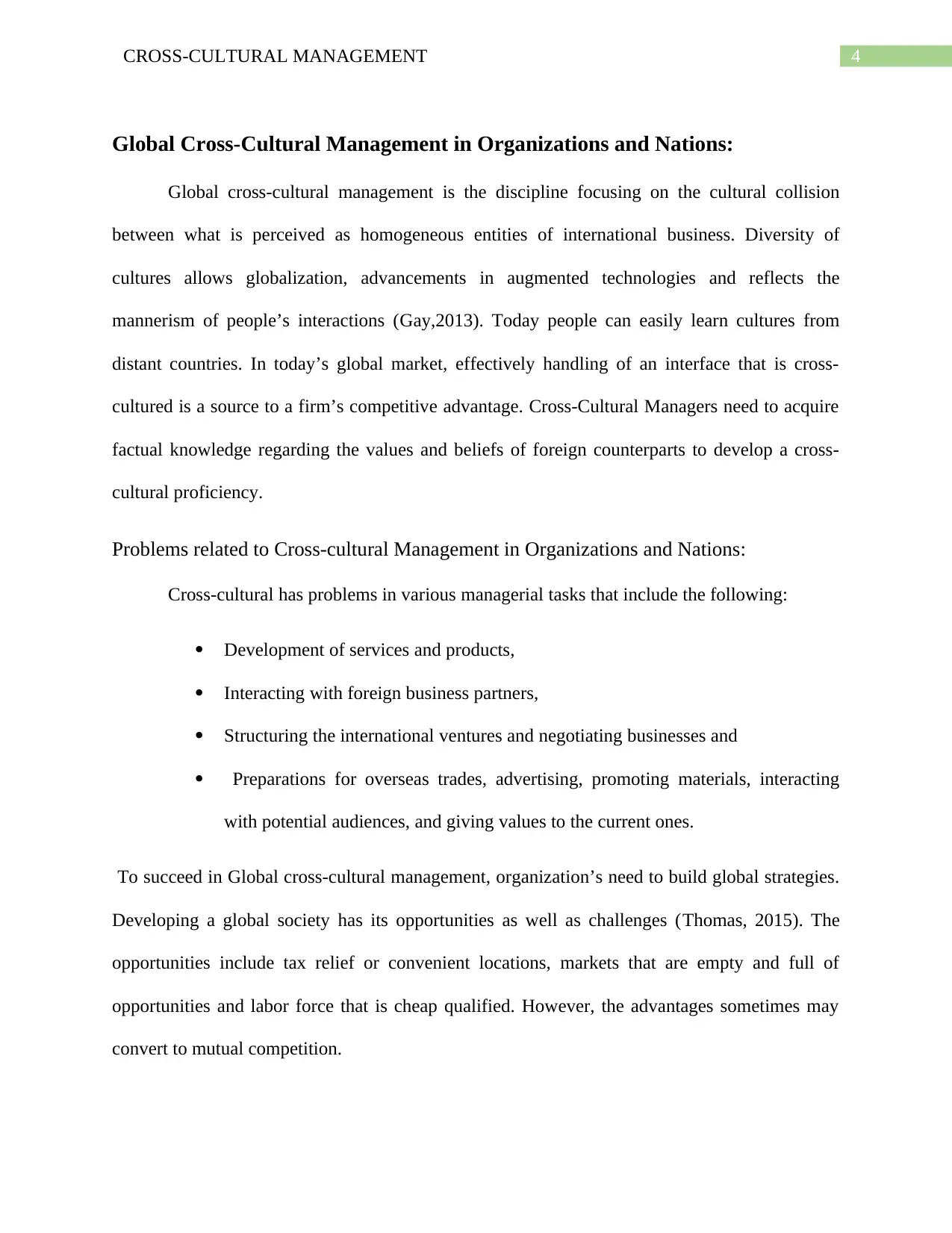
4CROSS-CULTURAL MANAGEMENT
Global Cross-Cultural Management in Organizations and Nations:
Global cross-cultural management is the discipline focusing on the cultural collision
between what is perceived as homogeneous entities of international business. Diversity of
cultures allows globalization, advancements in augmented technologies and reflects the
mannerism of people’s interactions (Gay,2013). Today people can easily learn cultures from
distant countries. In today’s global market, effectively handling of an interface that is cross-
cultured is a source to a firm’s competitive advantage. Cross-Cultural Managers need to acquire
factual knowledge regarding the values and beliefs of foreign counterparts to develop a cross-
cultural proficiency.
Problems related to Cross-cultural Management in Organizations and Nations:
Cross-cultural has problems in various managerial tasks that include the following:
Development of services and products,
Interacting with foreign business partners,
Structuring the international ventures and negotiating businesses and
Preparations for overseas trades, advertising, promoting materials, interacting
with potential audiences, and giving values to the current ones.
To succeed in Global cross-cultural management, organization’s need to build global strategies.
Developing a global society has its opportunities as well as challenges (Thomas, 2015). The
opportunities include tax relief or convenient locations, markets that are empty and full of
opportunities and labor force that is cheap qualified. However, the advantages sometimes may
convert to mutual competition.
Global Cross-Cultural Management in Organizations and Nations:
Global cross-cultural management is the discipline focusing on the cultural collision
between what is perceived as homogeneous entities of international business. Diversity of
cultures allows globalization, advancements in augmented technologies and reflects the
mannerism of people’s interactions (Gay,2013). Today people can easily learn cultures from
distant countries. In today’s global market, effectively handling of an interface that is cross-
cultured is a source to a firm’s competitive advantage. Cross-Cultural Managers need to acquire
factual knowledge regarding the values and beliefs of foreign counterparts to develop a cross-
cultural proficiency.
Problems related to Cross-cultural Management in Organizations and Nations:
Cross-cultural has problems in various managerial tasks that include the following:
Development of services and products,
Interacting with foreign business partners,
Structuring the international ventures and negotiating businesses and
Preparations for overseas trades, advertising, promoting materials, interacting
with potential audiences, and giving values to the current ones.
To succeed in Global cross-cultural management, organization’s need to build global strategies.
Developing a global society has its opportunities as well as challenges (Thomas, 2015). The
opportunities include tax relief or convenient locations, markets that are empty and full of
opportunities and labor force that is cheap qualified. However, the advantages sometimes may
convert to mutual competition.
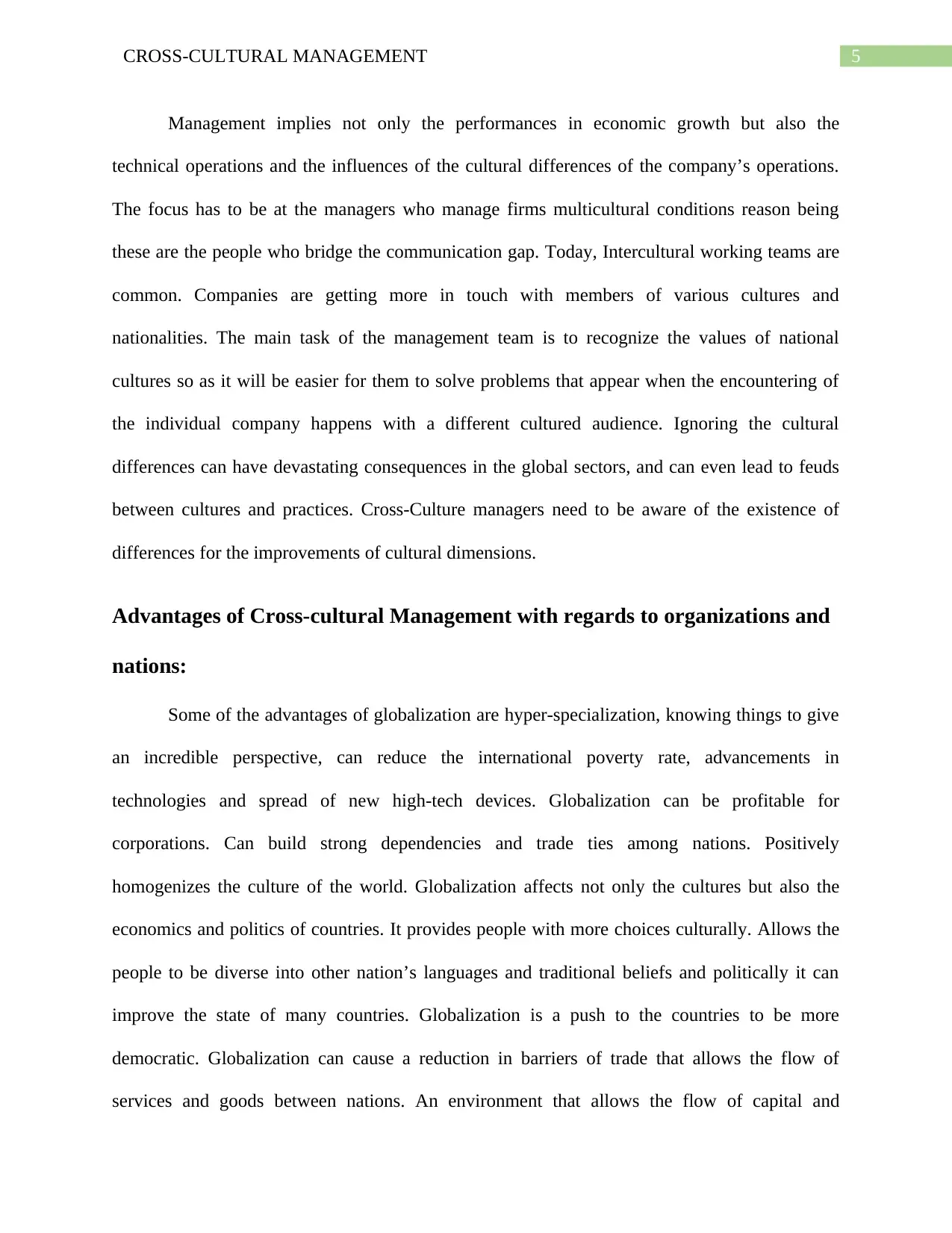
5CROSS-CULTURAL MANAGEMENT
Management implies not only the performances in economic growth but also the
technical operations and the influences of the cultural differences of the company’s operations.
The focus has to be at the managers who manage firms multicultural conditions reason being
these are the people who bridge the communication gap. Today, Intercultural working teams are
common. Companies are getting more in touch with members of various cultures and
nationalities. The main task of the management team is to recognize the values of national
cultures so as it will be easier for them to solve problems that appear when the encountering of
the individual company happens with a different cultured audience. Ignoring the cultural
differences can have devastating consequences in the global sectors, and can even lead to feuds
between cultures and practices. Cross-Culture managers need to be aware of the existence of
differences for the improvements of cultural dimensions.
Advantages of Cross-cultural Management with regards to organizations and
nations:
Some of the advantages of globalization are hyper-specialization, knowing things to give
an incredible perspective, can reduce the international poverty rate, advancements in
technologies and spread of new high-tech devices. Globalization can be profitable for
corporations. Can build strong dependencies and trade ties among nations. Positively
homogenizes the culture of the world. Globalization affects not only the cultures but also the
economics and politics of countries. It provides people with more choices culturally. Allows the
people to be diverse into other nation’s languages and traditional beliefs and politically it can
improve the state of many countries. Globalization is a push to the countries to be more
democratic. Globalization can cause a reduction in barriers of trade that allows the flow of
services and goods between nations. An environment that allows the flow of capital and
Management implies not only the performances in economic growth but also the
technical operations and the influences of the cultural differences of the company’s operations.
The focus has to be at the managers who manage firms multicultural conditions reason being
these are the people who bridge the communication gap. Today, Intercultural working teams are
common. Companies are getting more in touch with members of various cultures and
nationalities. The main task of the management team is to recognize the values of national
cultures so as it will be easier for them to solve problems that appear when the encountering of
the individual company happens with a different cultured audience. Ignoring the cultural
differences can have devastating consequences in the global sectors, and can even lead to feuds
between cultures and practices. Cross-Culture managers need to be aware of the existence of
differences for the improvements of cultural dimensions.
Advantages of Cross-cultural Management with regards to organizations and
nations:
Some of the advantages of globalization are hyper-specialization, knowing things to give
an incredible perspective, can reduce the international poverty rate, advancements in
technologies and spread of new high-tech devices. Globalization can be profitable for
corporations. Can build strong dependencies and trade ties among nations. Positively
homogenizes the culture of the world. Globalization affects not only the cultures but also the
economics and politics of countries. It provides people with more choices culturally. Allows the
people to be diverse into other nation’s languages and traditional beliefs and politically it can
improve the state of many countries. Globalization is a push to the countries to be more
democratic. Globalization can cause a reduction in barriers of trade that allows the flow of
services and goods between nations. An environment that allows the flow of capital and
⊘ This is a preview!⊘
Do you want full access?
Subscribe today to unlock all pages.

Trusted by 1+ million students worldwide
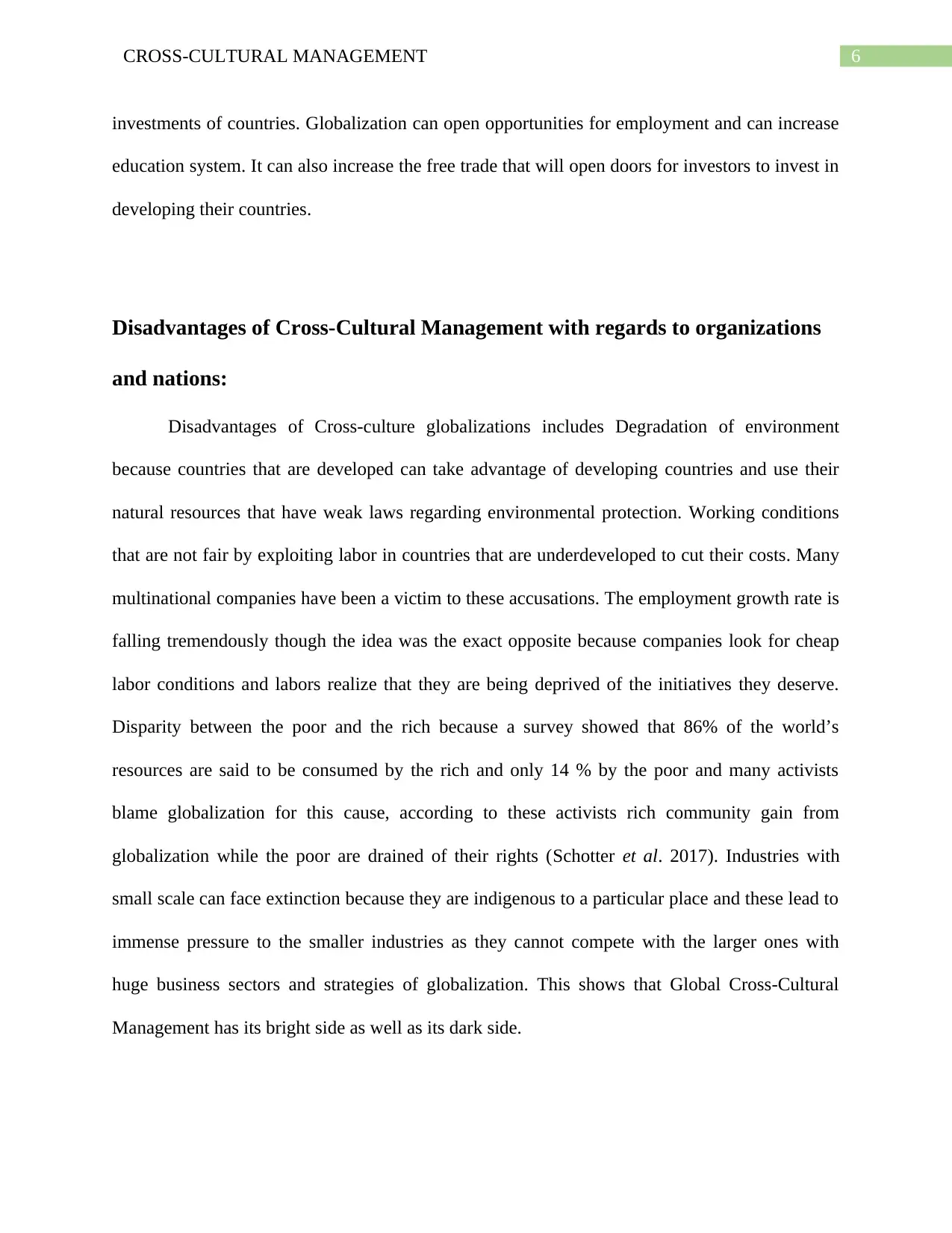
6CROSS-CULTURAL MANAGEMENT
investments of countries. Globalization can open opportunities for employment and can increase
education system. It can also increase the free trade that will open doors for investors to invest in
developing their countries.
Disadvantages of Cross-Cultural Management with regards to organizations
and nations:
Disadvantages of Cross-culture globalizations includes Degradation of environment
because countries that are developed can take advantage of developing countries and use their
natural resources that have weak laws regarding environmental protection. Working conditions
that are not fair by exploiting labor in countries that are underdeveloped to cut their costs. Many
multinational companies have been a victim to these accusations. The employment growth rate is
falling tremendously though the idea was the exact opposite because companies look for cheap
labor conditions and labors realize that they are being deprived of the initiatives they deserve.
Disparity between the poor and the rich because a survey showed that 86% of the world’s
resources are said to be consumed by the rich and only 14 % by the poor and many activists
blame globalization for this cause, according to these activists rich community gain from
globalization while the poor are drained of their rights (Schotter et al. 2017). Industries with
small scale can face extinction because they are indigenous to a particular place and these lead to
immense pressure to the smaller industries as they cannot compete with the larger ones with
huge business sectors and strategies of globalization. This shows that Global Cross-Cultural
Management has its bright side as well as its dark side.
investments of countries. Globalization can open opportunities for employment and can increase
education system. It can also increase the free trade that will open doors for investors to invest in
developing their countries.
Disadvantages of Cross-Cultural Management with regards to organizations
and nations:
Disadvantages of Cross-culture globalizations includes Degradation of environment
because countries that are developed can take advantage of developing countries and use their
natural resources that have weak laws regarding environmental protection. Working conditions
that are not fair by exploiting labor in countries that are underdeveloped to cut their costs. Many
multinational companies have been a victim to these accusations. The employment growth rate is
falling tremendously though the idea was the exact opposite because companies look for cheap
labor conditions and labors realize that they are being deprived of the initiatives they deserve.
Disparity between the poor and the rich because a survey showed that 86% of the world’s
resources are said to be consumed by the rich and only 14 % by the poor and many activists
blame globalization for this cause, according to these activists rich community gain from
globalization while the poor are drained of their rights (Schotter et al. 2017). Industries with
small scale can face extinction because they are indigenous to a particular place and these lead to
immense pressure to the smaller industries as they cannot compete with the larger ones with
huge business sectors and strategies of globalization. This shows that Global Cross-Cultural
Management has its bright side as well as its dark side.
Paraphrase This Document
Need a fresh take? Get an instant paraphrase of this document with our AI Paraphraser
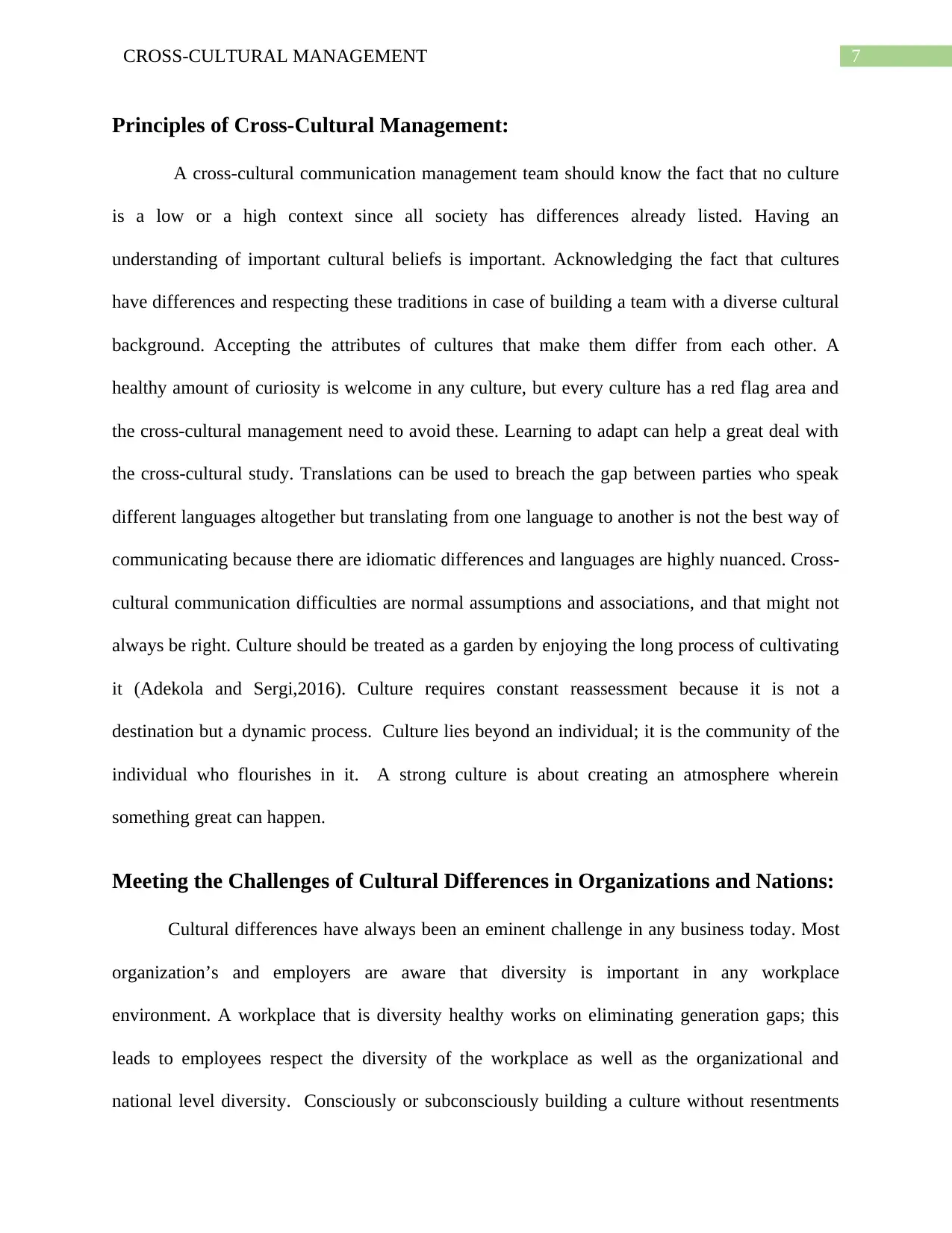
7CROSS-CULTURAL MANAGEMENT
Principles of Cross-Cultural Management:
A cross-cultural communication management team should know the fact that no culture
is a low or a high context since all society has differences already listed. Having an
understanding of important cultural beliefs is important. Acknowledging the fact that cultures
have differences and respecting these traditions in case of building a team with a diverse cultural
background. Accepting the attributes of cultures that make them differ from each other. A
healthy amount of curiosity is welcome in any culture, but every culture has a red flag area and
the cross-cultural management need to avoid these. Learning to adapt can help a great deal with
the cross-cultural study. Translations can be used to breach the gap between parties who speak
different languages altogether but translating from one language to another is not the best way of
communicating because there are idiomatic differences and languages are highly nuanced. Cross-
cultural communication difficulties are normal assumptions and associations, and that might not
always be right. Culture should be treated as a garden by enjoying the long process of cultivating
it (Adekola and Sergi,2016). Culture requires constant reassessment because it is not a
destination but a dynamic process. Culture lies beyond an individual; it is the community of the
individual who flourishes in it. A strong culture is about creating an atmosphere wherein
something great can happen.
Meeting the Challenges of Cultural Differences in Organizations and Nations:
Cultural differences have always been an eminent challenge in any business today. Most
organization’s and employers are aware that diversity is important in any workplace
environment. A workplace that is diversity healthy works on eliminating generation gaps; this
leads to employees respect the diversity of the workplace as well as the organizational and
national level diversity. Consciously or subconsciously building a culture without resentments
Principles of Cross-Cultural Management:
A cross-cultural communication management team should know the fact that no culture
is a low or a high context since all society has differences already listed. Having an
understanding of important cultural beliefs is important. Acknowledging the fact that cultures
have differences and respecting these traditions in case of building a team with a diverse cultural
background. Accepting the attributes of cultures that make them differ from each other. A
healthy amount of curiosity is welcome in any culture, but every culture has a red flag area and
the cross-cultural management need to avoid these. Learning to adapt can help a great deal with
the cross-cultural study. Translations can be used to breach the gap between parties who speak
different languages altogether but translating from one language to another is not the best way of
communicating because there are idiomatic differences and languages are highly nuanced. Cross-
cultural communication difficulties are normal assumptions and associations, and that might not
always be right. Culture should be treated as a garden by enjoying the long process of cultivating
it (Adekola and Sergi,2016). Culture requires constant reassessment because it is not a
destination but a dynamic process. Culture lies beyond an individual; it is the community of the
individual who flourishes in it. A strong culture is about creating an atmosphere wherein
something great can happen.
Meeting the Challenges of Cultural Differences in Organizations and Nations:
Cultural differences have always been an eminent challenge in any business today. Most
organization’s and employers are aware that diversity is important in any workplace
environment. A workplace that is diversity healthy works on eliminating generation gaps; this
leads to employees respect the diversity of the workplace as well as the organizational and
national level diversity. Consciously or subconsciously building a culture without resentments
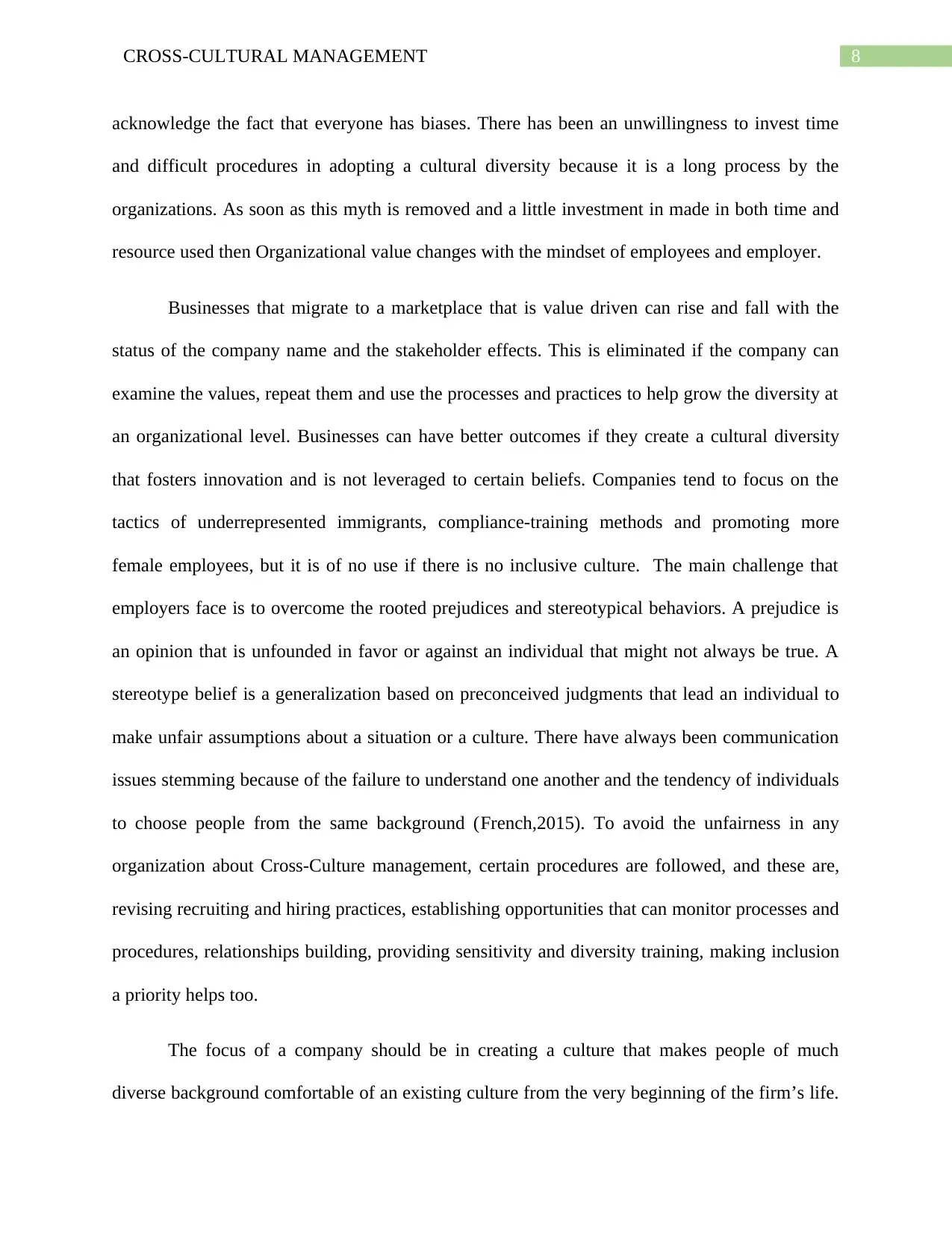
8CROSS-CULTURAL MANAGEMENT
acknowledge the fact that everyone has biases. There has been an unwillingness to invest time
and difficult procedures in adopting a cultural diversity because it is a long process by the
organizations. As soon as this myth is removed and a little investment in made in both time and
resource used then Organizational value changes with the mindset of employees and employer.
Businesses that migrate to a marketplace that is value driven can rise and fall with the
status of the company name and the stakeholder effects. This is eliminated if the company can
examine the values, repeat them and use the processes and practices to help grow the diversity at
an organizational level. Businesses can have better outcomes if they create a cultural diversity
that fosters innovation and is not leveraged to certain beliefs. Companies tend to focus on the
tactics of underrepresented immigrants, compliance-training methods and promoting more
female employees, but it is of no use if there is no inclusive culture. The main challenge that
employers face is to overcome the rooted prejudices and stereotypical behaviors. A prejudice is
an opinion that is unfounded in favor or against an individual that might not always be true. A
stereotype belief is a generalization based on preconceived judgments that lead an individual to
make unfair assumptions about a situation or a culture. There have always been communication
issues stemming because of the failure to understand one another and the tendency of individuals
to choose people from the same background (French,2015). To avoid the unfairness in any
organization about Cross-Culture management, certain procedures are followed, and these are,
revising recruiting and hiring practices, establishing opportunities that can monitor processes and
procedures, relationships building, providing sensitivity and diversity training, making inclusion
a priority helps too.
The focus of a company should be in creating a culture that makes people of much
diverse background comfortable of an existing culture from the very beginning of the firm’s life.
acknowledge the fact that everyone has biases. There has been an unwillingness to invest time
and difficult procedures in adopting a cultural diversity because it is a long process by the
organizations. As soon as this myth is removed and a little investment in made in both time and
resource used then Organizational value changes with the mindset of employees and employer.
Businesses that migrate to a marketplace that is value driven can rise and fall with the
status of the company name and the stakeholder effects. This is eliminated if the company can
examine the values, repeat them and use the processes and practices to help grow the diversity at
an organizational level. Businesses can have better outcomes if they create a cultural diversity
that fosters innovation and is not leveraged to certain beliefs. Companies tend to focus on the
tactics of underrepresented immigrants, compliance-training methods and promoting more
female employees, but it is of no use if there is no inclusive culture. The main challenge that
employers face is to overcome the rooted prejudices and stereotypical behaviors. A prejudice is
an opinion that is unfounded in favor or against an individual that might not always be true. A
stereotype belief is a generalization based on preconceived judgments that lead an individual to
make unfair assumptions about a situation or a culture. There have always been communication
issues stemming because of the failure to understand one another and the tendency of individuals
to choose people from the same background (French,2015). To avoid the unfairness in any
organization about Cross-Culture management, certain procedures are followed, and these are,
revising recruiting and hiring practices, establishing opportunities that can monitor processes and
procedures, relationships building, providing sensitivity and diversity training, making inclusion
a priority helps too.
The focus of a company should be in creating a culture that makes people of much
diverse background comfortable of an existing culture from the very beginning of the firm’s life.
⊘ This is a preview!⊘
Do you want full access?
Subscribe today to unlock all pages.

Trusted by 1+ million students worldwide
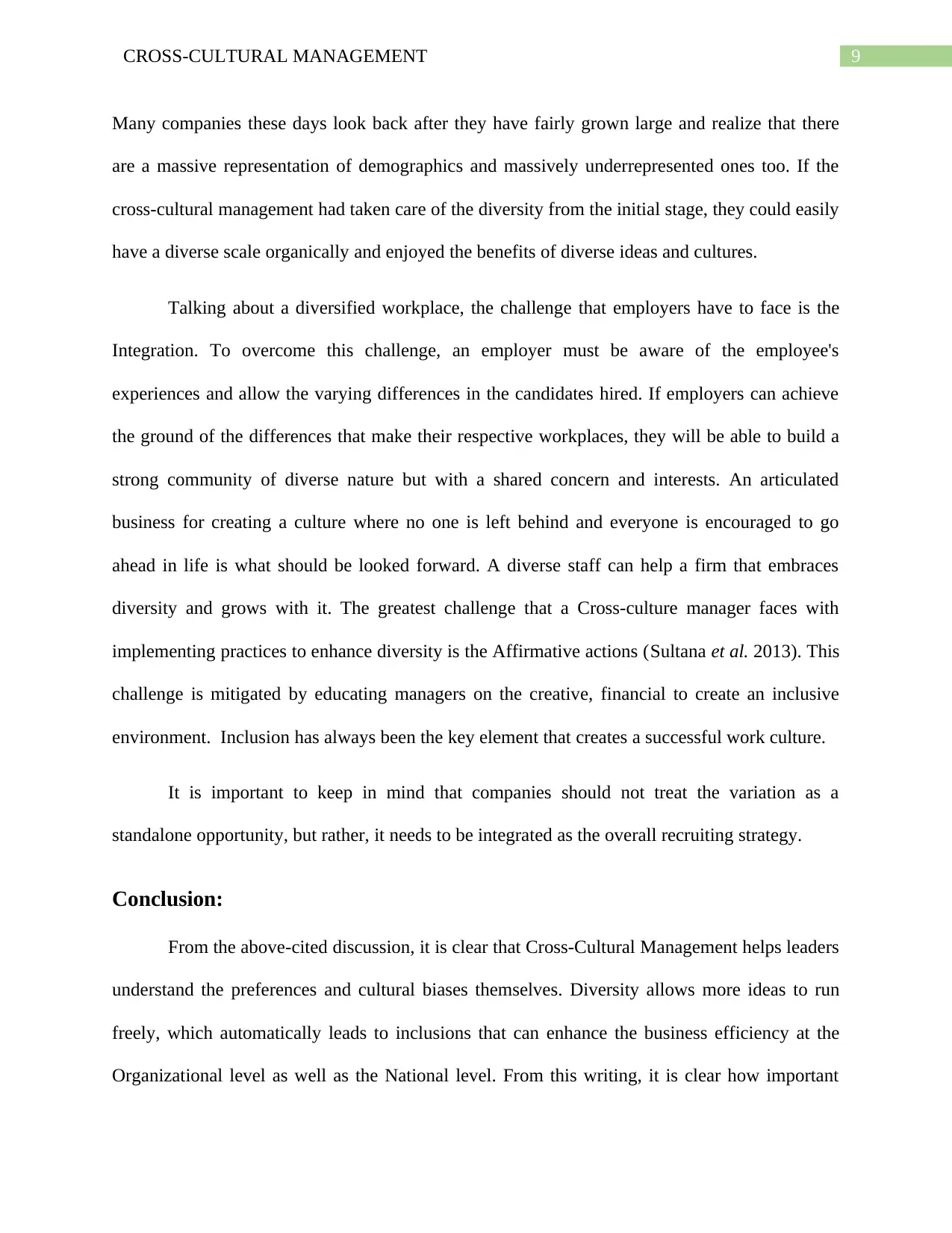
9CROSS-CULTURAL MANAGEMENT
Many companies these days look back after they have fairly grown large and realize that there
are a massive representation of demographics and massively underrepresented ones too. If the
cross-cultural management had taken care of the diversity from the initial stage, they could easily
have a diverse scale organically and enjoyed the benefits of diverse ideas and cultures.
Talking about a diversified workplace, the challenge that employers have to face is the
Integration. To overcome this challenge, an employer must be aware of the employee's
experiences and allow the varying differences in the candidates hired. If employers can achieve
the ground of the differences that make their respective workplaces, they will be able to build a
strong community of diverse nature but with a shared concern and interests. An articulated
business for creating a culture where no one is left behind and everyone is encouraged to go
ahead in life is what should be looked forward. A diverse staff can help a firm that embraces
diversity and grows with it. The greatest challenge that a Cross-culture manager faces with
implementing practices to enhance diversity is the Affirmative actions (Sultana et al. 2013). This
challenge is mitigated by educating managers on the creative, financial to create an inclusive
environment. Inclusion has always been the key element that creates a successful work culture.
It is important to keep in mind that companies should not treat the variation as a
standalone opportunity, but rather, it needs to be integrated as the overall recruiting strategy.
Conclusion:
From the above-cited discussion, it is clear that Cross-Cultural Management helps leaders
understand the preferences and cultural biases themselves. Diversity allows more ideas to run
freely, which automatically leads to inclusions that can enhance the business efficiency at the
Organizational level as well as the National level. From this writing, it is clear how important
Many companies these days look back after they have fairly grown large and realize that there
are a massive representation of demographics and massively underrepresented ones too. If the
cross-cultural management had taken care of the diversity from the initial stage, they could easily
have a diverse scale organically and enjoyed the benefits of diverse ideas and cultures.
Talking about a diversified workplace, the challenge that employers have to face is the
Integration. To overcome this challenge, an employer must be aware of the employee's
experiences and allow the varying differences in the candidates hired. If employers can achieve
the ground of the differences that make their respective workplaces, they will be able to build a
strong community of diverse nature but with a shared concern and interests. An articulated
business for creating a culture where no one is left behind and everyone is encouraged to go
ahead in life is what should be looked forward. A diverse staff can help a firm that embraces
diversity and grows with it. The greatest challenge that a Cross-culture manager faces with
implementing practices to enhance diversity is the Affirmative actions (Sultana et al. 2013). This
challenge is mitigated by educating managers on the creative, financial to create an inclusive
environment. Inclusion has always been the key element that creates a successful work culture.
It is important to keep in mind that companies should not treat the variation as a
standalone opportunity, but rather, it needs to be integrated as the overall recruiting strategy.
Conclusion:
From the above-cited discussion, it is clear that Cross-Cultural Management helps leaders
understand the preferences and cultural biases themselves. Diversity allows more ideas to run
freely, which automatically leads to inclusions that can enhance the business efficiency at the
Organizational level as well as the National level. From this writing, it is clear how important
Paraphrase This Document
Need a fresh take? Get an instant paraphrase of this document with our AI Paraphraser
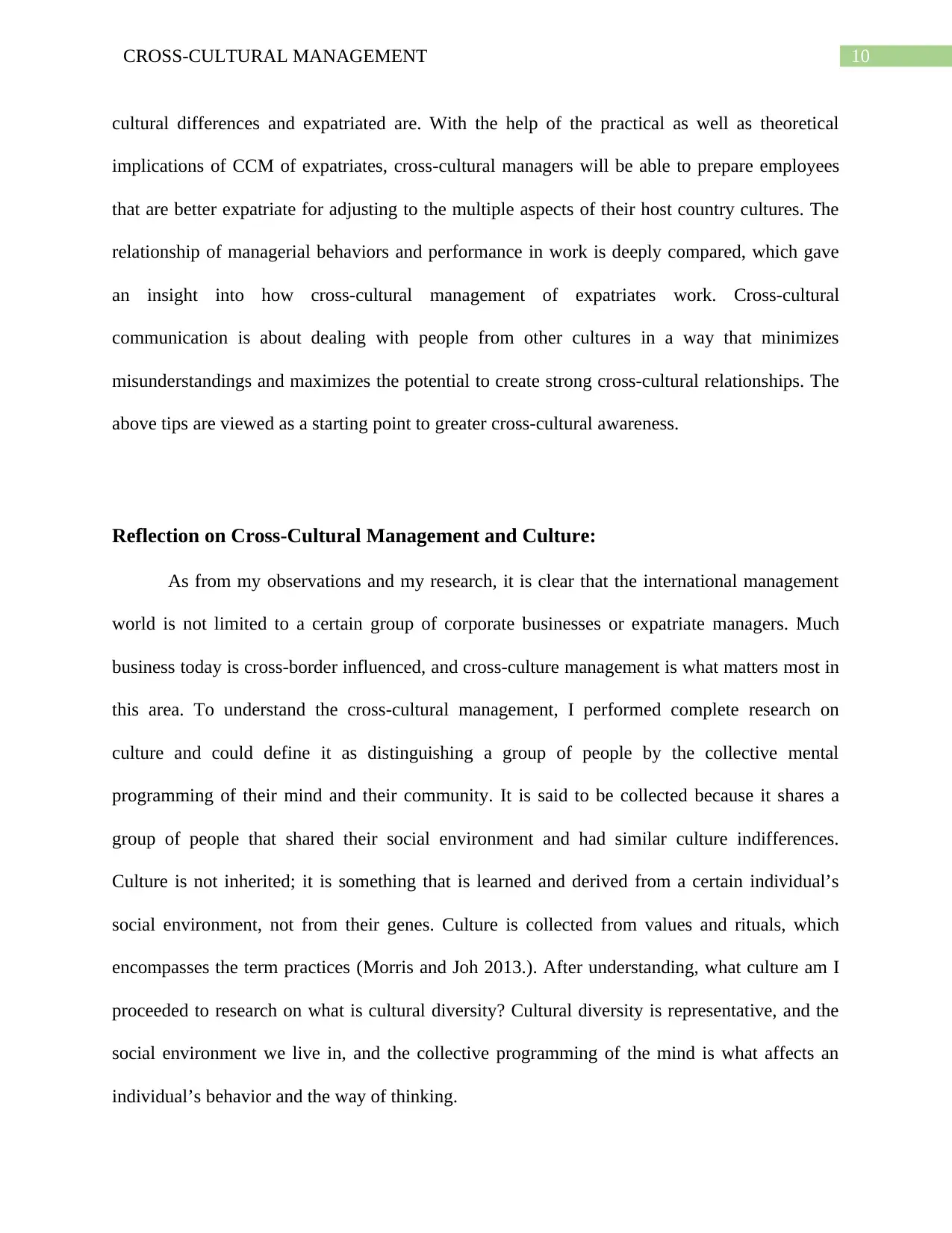
10CROSS-CULTURAL MANAGEMENT
cultural differences and expatriated are. With the help of the practical as well as theoretical
implications of CCM of expatriates, cross-cultural managers will be able to prepare employees
that are better expatriate for adjusting to the multiple aspects of their host country cultures. The
relationship of managerial behaviors and performance in work is deeply compared, which gave
an insight into how cross-cultural management of expatriates work. Cross-cultural
communication is about dealing with people from other cultures in a way that minimizes
misunderstandings and maximizes the potential to create strong cross-cultural relationships. The
above tips are viewed as a starting point to greater cross-cultural awareness.
Reflection on Cross-Cultural Management and Culture:
As from my observations and my research, it is clear that the international management
world is not limited to a certain group of corporate businesses or expatriate managers. Much
business today is cross-border influenced, and cross-culture management is what matters most in
this area. To understand the cross-cultural management, I performed complete research on
culture and could define it as distinguishing a group of people by the collective mental
programming of their mind and their community. It is said to be collected because it shares a
group of people that shared their social environment and had similar culture indifferences.
Culture is not inherited; it is something that is learned and derived from a certain individual’s
social environment, not from their genes. Culture is collected from values and rituals, which
encompasses the term practices (Morris and Joh 2013.). After understanding, what culture am I
proceeded to research on what is cultural diversity? Cultural diversity is representative, and the
social environment we live in, and the collective programming of the mind is what affects an
individual’s behavior and the way of thinking.
cultural differences and expatriated are. With the help of the practical as well as theoretical
implications of CCM of expatriates, cross-cultural managers will be able to prepare employees
that are better expatriate for adjusting to the multiple aspects of their host country cultures. The
relationship of managerial behaviors and performance in work is deeply compared, which gave
an insight into how cross-cultural management of expatriates work. Cross-cultural
communication is about dealing with people from other cultures in a way that minimizes
misunderstandings and maximizes the potential to create strong cross-cultural relationships. The
above tips are viewed as a starting point to greater cross-cultural awareness.
Reflection on Cross-Cultural Management and Culture:
As from my observations and my research, it is clear that the international management
world is not limited to a certain group of corporate businesses or expatriate managers. Much
business today is cross-border influenced, and cross-culture management is what matters most in
this area. To understand the cross-cultural management, I performed complete research on
culture and could define it as distinguishing a group of people by the collective mental
programming of their mind and their community. It is said to be collected because it shares a
group of people that shared their social environment and had similar culture indifferences.
Culture is not inherited; it is something that is learned and derived from a certain individual’s
social environment, not from their genes. Culture is collected from values and rituals, which
encompasses the term practices (Morris and Joh 2013.). After understanding, what culture am I
proceeded to research on what is cultural diversity? Cultural diversity is representative, and the
social environment we live in, and the collective programming of the mind is what affects an
individual’s behavior and the way of thinking.
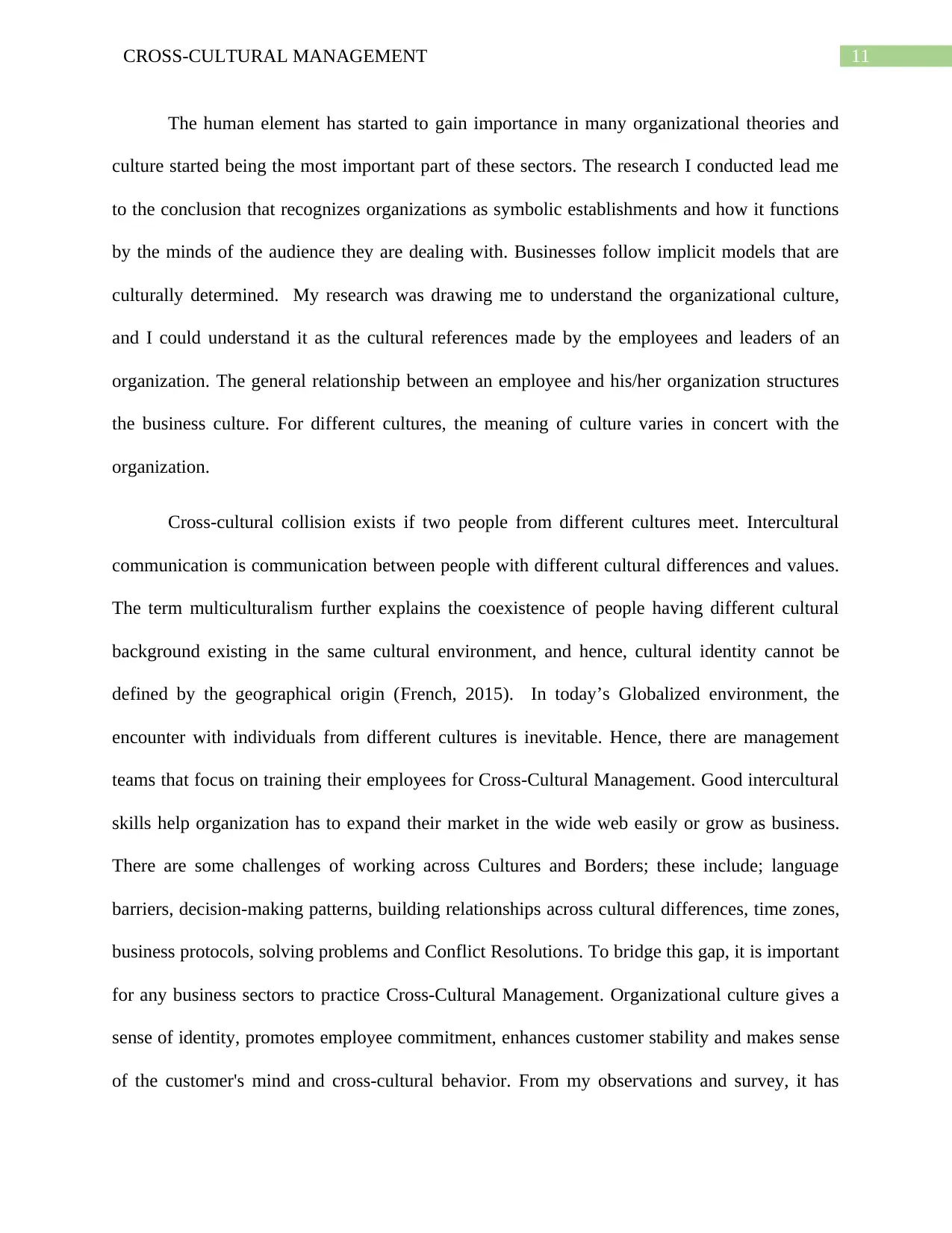
11CROSS-CULTURAL MANAGEMENT
The human element has started to gain importance in many organizational theories and
culture started being the most important part of these sectors. The research I conducted lead me
to the conclusion that recognizes organizations as symbolic establishments and how it functions
by the minds of the audience they are dealing with. Businesses follow implicit models that are
culturally determined. My research was drawing me to understand the organizational culture,
and I could understand it as the cultural references made by the employees and leaders of an
organization. The general relationship between an employee and his/her organization structures
the business culture. For different cultures, the meaning of culture varies in concert with the
organization.
Cross-cultural collision exists if two people from different cultures meet. Intercultural
communication is communication between people with different cultural differences and values.
The term multiculturalism further explains the coexistence of people having different cultural
background existing in the same cultural environment, and hence, cultural identity cannot be
defined by the geographical origin (French, 2015). In today’s Globalized environment, the
encounter with individuals from different cultures is inevitable. Hence, there are management
teams that focus on training their employees for Cross-Cultural Management. Good intercultural
skills help organization has to expand their market in the wide web easily or grow as business.
There are some challenges of working across Cultures and Borders; these include; language
barriers, decision-making patterns, building relationships across cultural differences, time zones,
business protocols, solving problems and Conflict Resolutions. To bridge this gap, it is important
for any business sectors to practice Cross-Cultural Management. Organizational culture gives a
sense of identity, promotes employee commitment, enhances customer stability and makes sense
of the customer's mind and cross-cultural behavior. From my observations and survey, it has
The human element has started to gain importance in many organizational theories and
culture started being the most important part of these sectors. The research I conducted lead me
to the conclusion that recognizes organizations as symbolic establishments and how it functions
by the minds of the audience they are dealing with. Businesses follow implicit models that are
culturally determined. My research was drawing me to understand the organizational culture,
and I could understand it as the cultural references made by the employees and leaders of an
organization. The general relationship between an employee and his/her organization structures
the business culture. For different cultures, the meaning of culture varies in concert with the
organization.
Cross-cultural collision exists if two people from different cultures meet. Intercultural
communication is communication between people with different cultural differences and values.
The term multiculturalism further explains the coexistence of people having different cultural
background existing in the same cultural environment, and hence, cultural identity cannot be
defined by the geographical origin (French, 2015). In today’s Globalized environment, the
encounter with individuals from different cultures is inevitable. Hence, there are management
teams that focus on training their employees for Cross-Cultural Management. Good intercultural
skills help organization has to expand their market in the wide web easily or grow as business.
There are some challenges of working across Cultures and Borders; these include; language
barriers, decision-making patterns, building relationships across cultural differences, time zones,
business protocols, solving problems and Conflict Resolutions. To bridge this gap, it is important
for any business sectors to practice Cross-Cultural Management. Organizational culture gives a
sense of identity, promotes employee commitment, enhances customer stability and makes sense
of the customer's mind and cross-cultural behavior. From my observations and survey, it has
⊘ This is a preview!⊘
Do you want full access?
Subscribe today to unlock all pages.

Trusted by 1+ million students worldwide
1 out of 13
Related Documents
Your All-in-One AI-Powered Toolkit for Academic Success.
+13062052269
info@desklib.com
Available 24*7 on WhatsApp / Email
![[object Object]](/_next/static/media/star-bottom.7253800d.svg)
Unlock your academic potential
Copyright © 2020–2025 A2Z Services. All Rights Reserved. Developed and managed by ZUCOL.





